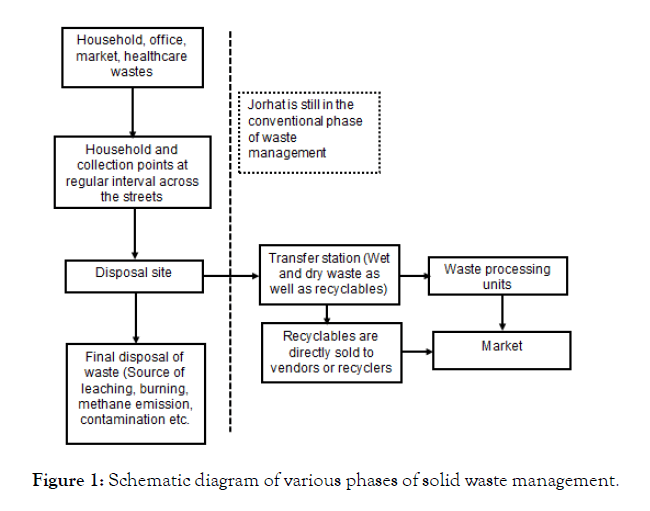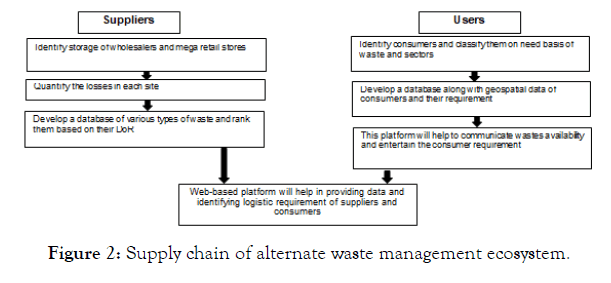Indexed In
- Open J Gate
- The Global Impact Factor (GIF)
- Open Archive Initiative
- VieSearch
- International Society of Universal Research in Sciences
- China National Knowledge Infrastructure (CNKI)
- CiteFactor
- Scimago
- Ulrich's Periodicals Directory
- Electronic Journals Library
- RefSeek
- Directory of Research Journal Indexing (DRJI)
- Hamdard University
- EBSCO A-Z
- Publons
- Google Scholar
Useful Links
Share This Page
Journal Flyer

Open Access Journals
- Agri and Aquaculture
- Biochemistry
- Bioinformatics & Systems Biology
- Business & Management
- Chemistry
- Clinical Sciences
- Engineering
- Food & Nutrition
- General Science
- Genetics & Molecular Biology
- Immunology & Microbiology
- Medical Sciences
- Neuroscience & Psychology
- Nursing & Health Care
- Pharmaceutical Sciences
Original Research Article - (2021) Volume 11, Issue 5
Waste Management Scenario in Jorhat, Assam
Aditya Bhuyan*Received: 01-Mar-2021 Published: 27-Apr-2021, DOI: 10.35248/2252-5211.21.11.409
Abstract
Solid waste management is a major challenge at local, regional and global level. Jorhat, a major urban agglomeration in Assam, India, produces approx. 35 Tons per day (TPD) of municipal waste which is expected to increase up to 39 TPD and 58 TPD by 2025 and 2035 respectively. With such increased future waste production projection, without any focus on waste management, the city will face acute problems leading to health and sanitary issues. There is a single open disposal site in Jorhat without any facility for recycling or infrastructure for a scientific sanitary landfill at the site. Since 2019, the waste collection facility has improved significantly with daily collection of household from majority of wards across the city. However, the question remains regarding the management of the wastes produced. So, a comprehensive plan for solid waste management as well as its execution should start at the earliest hour with focus on transitioning the economy from linear to circular one thus closing the material loop.
Keywords
Municipal waste; Waste management; Circularity; Jorhat city
Introduction
With an increase in urban population in the tier II and tier III cities in India, waste produced has also amplified many folds. Management of the municipal solid waste in Indian cities is in a precarious state due to lack of infrastructure as well as planning. In 2019-20, Maharastra generated the highest quantity of solid waste in India (23,844.6 TPD). Assam was ranked 20th in terms of waste generated per day. Urban waste is considered to the highest contributor due to accelerated industry growth and citizen migration from rural to urban areas [1]. Jorhat, a major city in Assam has been declared as the cleanest city in North-east region in the category of population of 50K-1L by Swachh Bharat Abhiyan campaign, 2020. It was ranked 158 in the previous year among the other North-Eastern cities. Though the city has improved significantly in terms of household collection of waste yet calling it the cleanest city doesn’t do justice due to its lack of proper public collection points both for residential as well as commercial purposes, recycling of the waste collected and its unscientific and unsanitary disposal.
The current study is an attempt to understand the existing scenario of solid waste management in the city of Jorhat along with the loopholes and challenges involved in its management. Municipal waste is referred to anything which includes household wastes, wastes from commercial activities, construction debris, sewage treatment residues etc. In Jorhat, waste generated is estimated to be 35MT/day [1] and is expected to increase up to 39TPD and 58TPD by 2025 and 2035 respectively [2]. So, a comprehensive plan for solid waste management as well as its execution should start at the earliest hour.
Waste Disposal in Jorhat
Jorhat city is situated at geographic location 26.7509° N Longitude, 94.2037° E latitude and is the headquarters of the district. It is one of the major commercial hub of Assam and is also known as the cultural capital. With rapid urbanisation, the population is expected to increase at a rate of 41% by 2025. With such increased future population projection, without any focus on waste management, the city will face acute problems leading to health and sanitary issues. The waste disposal site of Jorhat is in Garamur dumping ground beside the bhogdoi river. It is an open dumping site without any facility for recycling or infrastructure for a scientific sanitary landfill at the site. Bhogdoiriver is one of the major source of drinking water for the entire city as well as its nearby areas.
The environmental impacts if solid municipal waste is disposed in open dumpsites are
• Ground water contamination due to runoff of the leachate
• Greenhouse gases emitted from the wastes will not only affect the neighbouring places but also have a potential to catch fire at the disposal site to excessive methane emissions
• Surface water contamination due to runoff of wastes
• Bad odour, pests as well as serious health issues of nearby residents
Due to close proximity of the open dumpsite to bhogdoi river as well as the city (2 km), it poses all the above mentioned risks to the citizens of Jorhat. Recently due to increase in rainfall, there were incidents of increasing in water level near the dumpsite which led to runoff of the wastes into the river thus degrading the surface water quality of Bhogdoi. There is also a direct correlation between improper disposal of solid wastes and vector borne diseases and the local residents are also very apprehensive of the disposal at that site. A comprehensive plan has been prepared with an estimation of INR 33 crore for solid waste management starting from collection to scientific disposal including composting [2]. Waste collection in Jorhat has improved significantly since the last few years. According to the 2016-17 data, there were 2 trucks, 1 tractor, 4 trailers, 4 hand cart and 65 dust bins. However, since then, dustbins have increased across the streets. Since the 2019,household collection has also started in majority of the wards. Detailed structured interview with municipality officials revealed that from 2021, there are plans to make the entire city dustbin free without any public collection points inside the city premises. Though household collection of wastes in all the wards have started since 2020, waste generated by commercial entities still needs to be addressed. As vehicles available for waste collection are limited, there are huge piles of waste getting collected in the streets.
Due to lack of awareness among the citizens there is no segregation process of wastes altogether, both by the residents as well as at the dumping site. In certain parts of the city such as Marwaripatty and Old circuit road (major commercial centres), there is open dumping of wastes even after the presence of dustbins. The citizens should also be held accountable in disposing wastes in a proper manner at these sites. According to a survey conducted for the Neer Nirmal Pariyojana Project, it is estimated that 38.3% of families burnt their wastes. This also releases huge amount of harmful pollutants (PM2.5, PM10, SOx, VOCs etc.) as well as other Greenhouse gases. Efficient collection of wastes definitely helps in keeping the city clean as well as maintain good sanitisation quality. Therefore, without its management at the disposal site, will not only be harmful for the residents but also acutely harm the entire ecosystem (Figure 1).

Figure 1: Schematic diagram of various phases of solid waste management.
Alternatives to Open Dumping
Reducing the waste produced should be the first and foremost measure for decreasing the load on landfills and open dumping sites. Apart from reducing, segregation is another important aspect of waste management with respect to its contents; be it dry or wet and bio-degradable or non-biodegradable. Dry wastes with high calorific value could be further treated or directly used for energy generation. Wet bio-degradable waste can be used for manufacturing bio-fertilisers, compost as well as biogas.
For efficient utilisation of the wastes disposed, a digital marketplace could play a pivotal role where discarded products/wastes can be exchanged, recycled or utilised thus creating a circularity and closing the material loop. These platforms can act as business-to-business marketplaces where customers including general public as well as companies interacting to exchange these materials for application such as reusing, recycling, obtainment of goods for remanufacturing or purchasing of recyclate to use in production. Here, analytical capabilities of data science through “Fast data” or “Big Data” can be utilized which will help the authorities to monitor, evaluate and understand the emerging resources and value stream [3]. Data collected and provided by the users should include information on the status/quality of the material, the composition of the materials such as presence of any potential additives or hazardous ingredients, the quantity of supply/demand and also clarify the time of supply and demand.
Through such platforms both the suppliers as well as consumers can benefit. The suppliers can realize the current price in conformity of the quality of the products listed which helps them to not suffer from consumer externalities. In the same way, the consumers achieve clarity and certainty regarding materials and the goods they obtain for reuse or recycle [4]. The use of digital platforms for such a purpose can help Jorhat to transform from a linear economy to a circular one (Figure 2).

Figure 2: Supply chain of alternate waste management ecosystem.
Moreover, the platform will segregate different types of wastes on the basis of the cause of loss [5] and their Degree of Recoverability (DoR) [6]. This segregation will help in understanding the variability of wastes produced and requirement of consumers from different sectors. Starting from metal and paper recyclers to decompose manufacturer, mapping of these stakeholders will help in creating an ecosystem which helps to reduce the waste that are usually disposed in the open dumpsites.
According to the waste management hierarchy, disposal of wastes should be the last option for its management and should be restricted to only non-biodegradable, inert as well as waste which cannot be further recycled or reused. Further, planning of a scientific landfill site is the need of the hour for Jorhat city. Though a few projects have been planned for better management of waste, its implementation on-ground is non-existent. Due to the open disposal of waste, in long term it will impact the health of the residents as well as the riverine ecosystem of Bhogdoi and the entire city.
REFERENCES
- Choudhury M, Dutta J. A comparative study of municipal solid waste management status for three major towns of Upper Assam-India. Int J Waste Res. 2017;7(3):1-8.
- advantageassam.com/assets/front/pdf/shelf-of-projects/Urban-Infrastructure/Solid-Waste-Management-Jorhat.pdf
- Berg H, Wilts H. Digital platforms as market places for the circular economy—requirements and challenges. In Nachhaltigkeits Management Forum| Sustainability Management Forum. Springer Berlin Heidelberg. 2019;27: 1-9.
- Clark W, Couldry N, MacDonald R, Stephansen HC. Digital platforms and narrative exchange: Hidden constraints, emerging agency. New Media & Society. 2015;17(6):919-938.
- Shukla M, Jharkharia S. Agri-fresh produce supply chain management: a state‐of‐the‐art literature review. Int J Operations & Production Manag. 2013;33:114–158.
- Garrone P, Melacini M, Perego A. Opening the black box of food waste reduction. Food policy. 2014 ;46:129-39.
Citation: Aditya B (2021) Waste Management Scenario in Jorhat, Assam. Int J Waste Resour 11: 409. doi: 10.35248/2252-5211.21.11.409
Copyright: © 2021 Aditya B. This is an open access article distributed under the terms of the Creative Commons Attribution License, which permits unrestricted use, distribution, and reproduction in any medium, provided the original work is properly cited.

